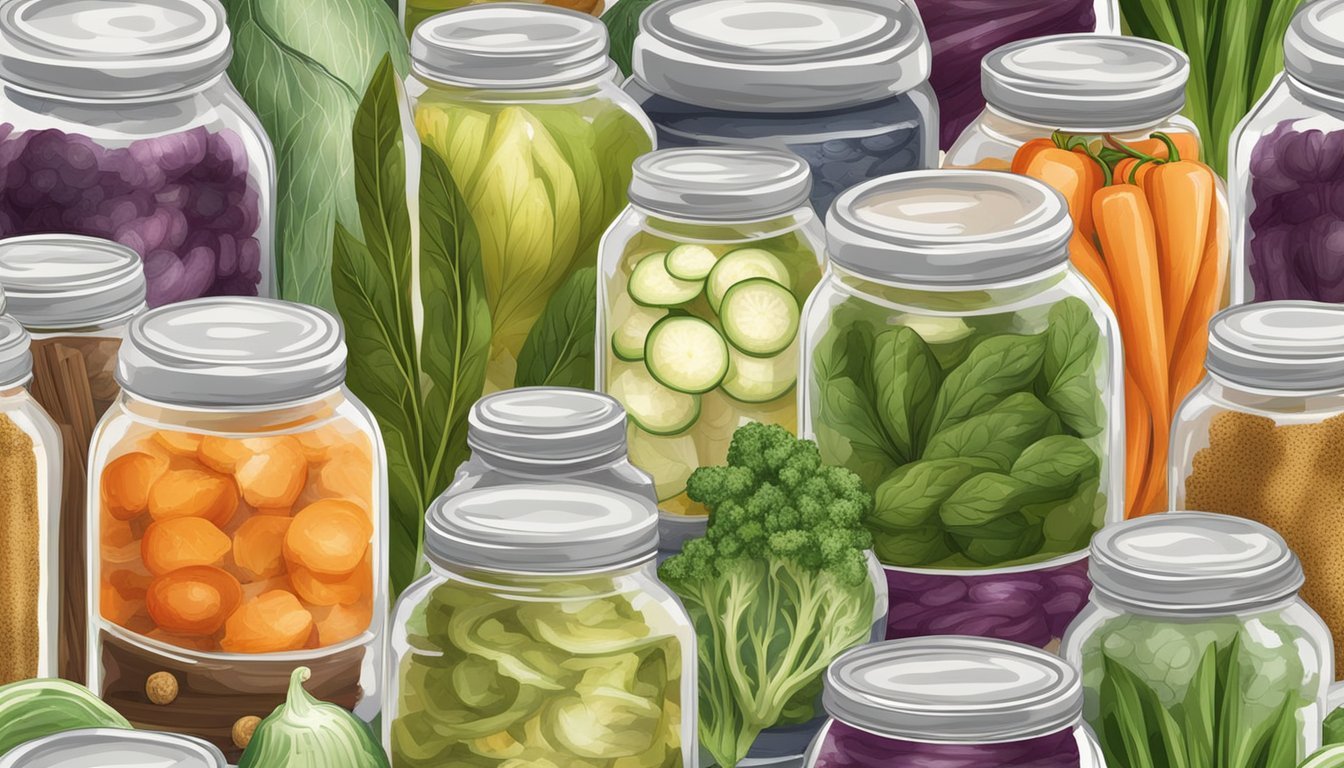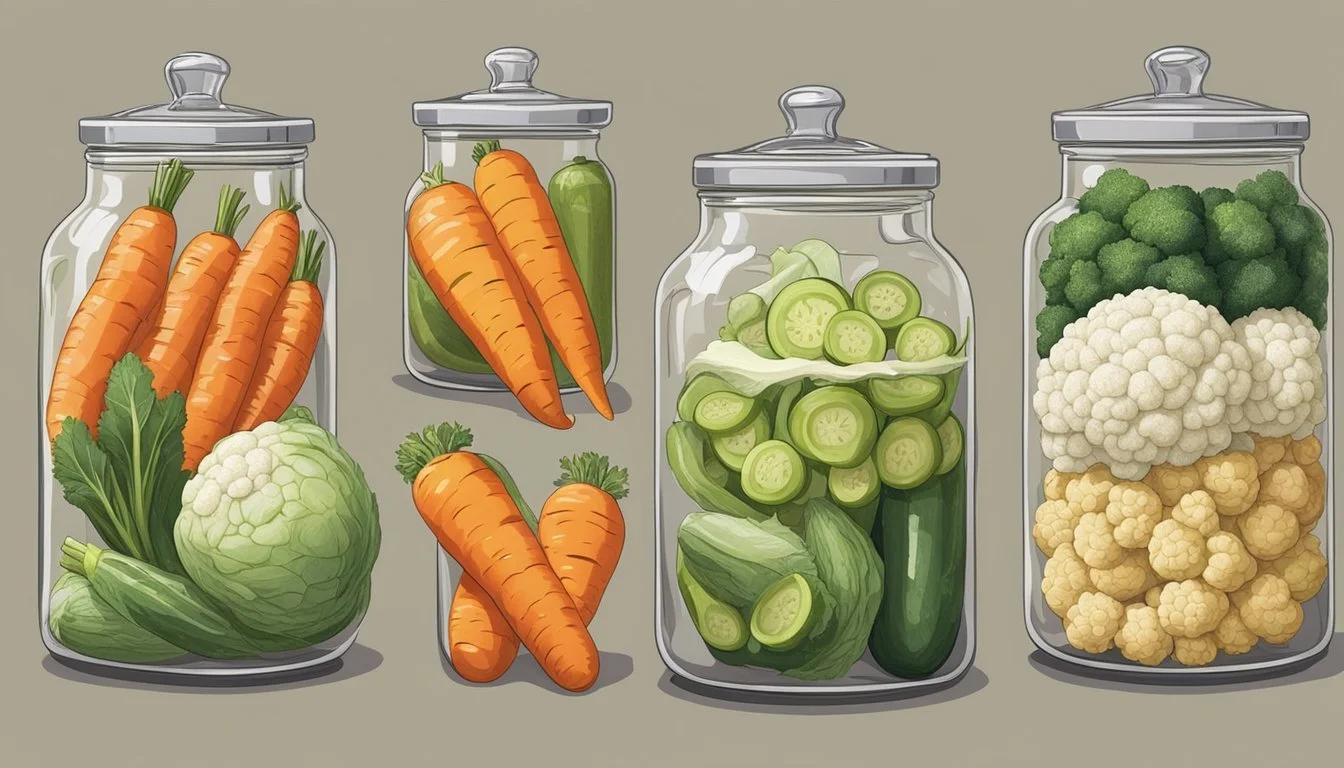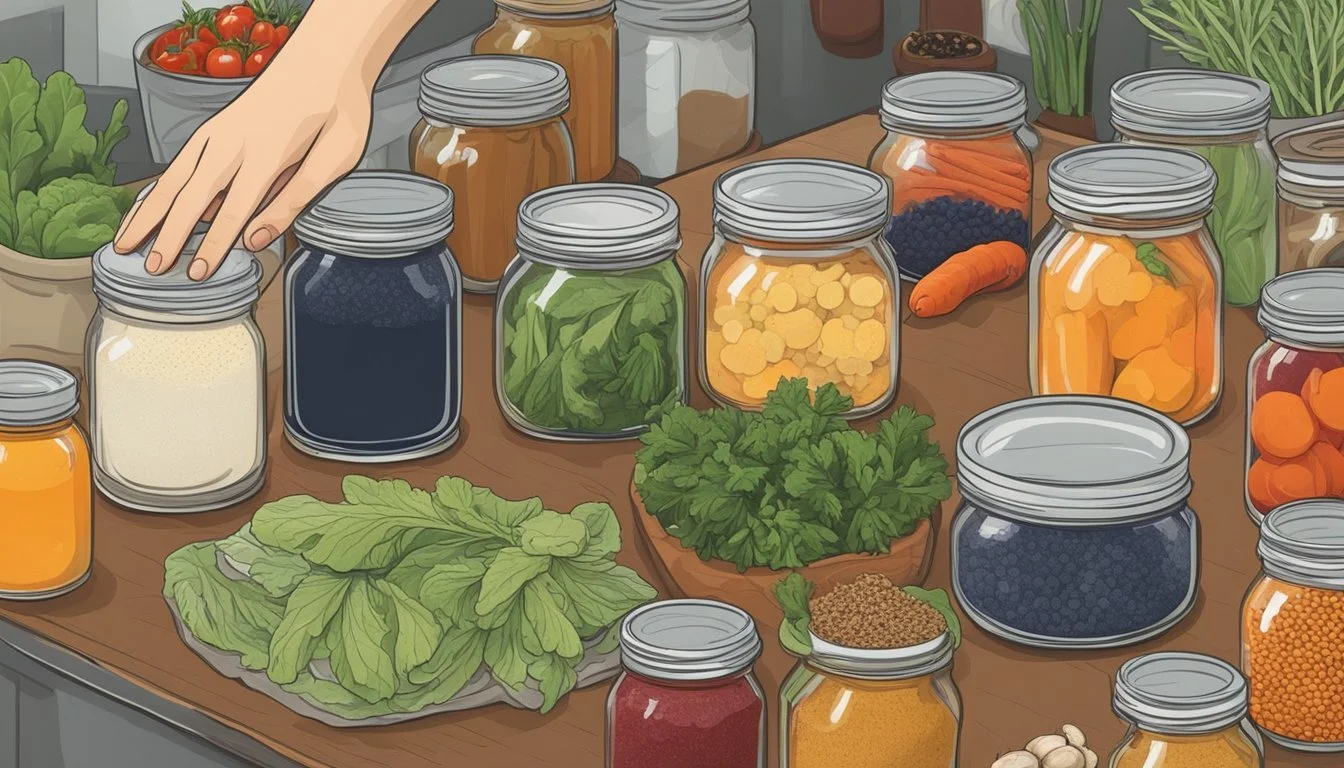How to Ferment Torshi
Your Guide to Middle Eastern Pickled Vegetables
Torshi embodies the rich culinary traditions of the Middle East, where fermenting vegetables is a revered practice to enhance the flavors and preserve the bounty of the harvest. Originating from the Persian word "torsh," which means "sour," torshi is a popular condiment prepared by fermenting a variety of vegetables in vinegar or brine. In kitchens across Iran and neighboring countries, torshi is not merely a side dish, but a celebration of texture, taste, and the art of patience, as the fermentation process unfolds over time.
The process of fermenting torshi starts with selecting fresh vegetables which often include cauliflower, carrots, celery, and eggplant. These are then cut into desired shapes and sizes, prepared via blanching or mashing depending on the recipe, and are then submerged in a flavorful pickling solution. The solution typically features vinegar, combined with salt, water, and at times, spices like turmeric, which contribute to torshi's distinct vibrant hue and tangy flavor profile.
As a staple of Persian and wider Middle Eastern cuisine, torshi is not only a testament to the region's ingenuity in food preservation but also a versatile companion to a myriad of dishes. It enhances palates with its acidic bite and is often enjoyed alongside grilled meats, rice dishes, or as part of a mezze platter. The fermentation not only imparts a sharp, appetizing flavor but also increases the longevity of vegetables, making torshi a practical and much-loved element of the regional diet.
History and Significance
Torshi, the traditional Middle Eastern pickled vegetables, (What wine goes well with pickled vegetables?) embody a rich tapestry of cultural and culinary practices. They are not just food items, but a significant part of regional identities across the Middle East, intimately tied to the culinary traditions and practices of different communities.
Cultural Background
Torshi has its roots in the Persian word "torsh," which translates to "sour" in Farsi. In the gastronomy of Iran, and extending to other Middle Eastern cultures, it is a staple condiment, particularly relished in the colder autumn and winter months. Iranian families often prepare torshi at home, embracing a variety of recipes that have been passed down through generations. The ritual of torshi-making is an age-old practice that traditionally brings families together.
Central to Persian cuisine, torshi is usually served with meals to complement and enhance the flavor profile of the dishes. In many households, the practice of preserving vegetables by pickling is an essential method to extend their shelf life, especially as a way to make use of autumn harvests for the leaner winter season.
Regional Variations
Across the Middle East, torshi is known by various names and comes in an array of local variations. Each region adds a distinct touch to their pickles, often reflecting the local palate and available produce. For instance:
Persian Torshi: In Iran, it can include a mix of herbs, vegetables, and sometimes fruits, with vinegar and spices, and it's common for the preparation to be allowed to ferment for an extended period.
Afghan Torshi: Afghanistan has its versions too, which might include a blend of hot and sweet flavors, using local spices.
Assyrian Torshi: The Assyrian community often incorporates similar pickling methods, adding unique spices and favoring certain vegetables.
Balkan and Mediterranean Inclinations: The practice extends into the Balkan and Mediterranean regions, with each nation infusing its culinary essence into the pickled concoctions.
As the concept of torshi migrated through different cultures, it evolved to adapt to the tastes and available resources of each area, highlighting not only the versatility of pickling as a food preservation method but also its role in cultural identity.
Health Benefits
Torshi, a Middle Eastern specialty of pickled vegetables, offers a range of health benefits mainly due to its rich nutritional profile and the lacto-fermentation process it undergoes.
Nutritional Value
Probiotics: Torshi is a source of probiotics, the beneficial bacteria that are crucial for a healthy gut microbiome. A 100 g serving of torshi may contain lactic acid bacteria which are a type of probiotic. Vitamins and Minerals: The vegetables in torshi are often low in calories but high in vitamins and minerals, making it a nutritious addition to any diet.
Lacto-Fermentation Process
Lactic Acid: Lacto-fermentation is a natural preservation method that enhances the digestibility of the food. The lactic acid produced during this process not only preserves the vegetables by lowering the pH but also gives torshi its distinctive sour taste. Acidity: The controlled acidity of the ferment creates an environment that inhibits harmful bacteria, while allowing probiotics to proliferate, which can benefit digestive health.
Choosing Ingredients
When fermenting Middle Eastern Torshi, the choice of vegetables and the blend of herbs and spices are crucial to achieving the desired flavor and preserving qualities.
Selecting Vegetables
Vegetables are the foundation of Torshi. The most common vegetables used include:
Cauliflower: A crisp option that absorbs flavors well.
Carrots: Adds sweetness and crunch.
Peppers: Offers a spicy kick, ranging from mild to hot.
Celery: Provides a distinct, aromatic crunch.
Cucumbers: These are classic for pickling with a satisfyingly crisp texture.
Eggplant: Known for its ability to soak up flavors.
Cabbage: A good base for any Torshi, giving a tender texture.
Green Beans: They retain a firm texture and provide a fresh snap.
Turnips: Contributing a sharp, earthy flavor complexity.
Green Tomatoes: A sour element, perfect for pickling.
Olives: Already a staple in Middle Eastern cuisine, they add a unique richness.
Choosing fresh and high-quality vegetables ensures the final product is both tasty and safe for consumption.
Herbs and Spices
Herbs and spices are integral to infusing Torshi with its distinctive flavor. When selecting these, consider using:
Turmeric: It imparts a warm, bitter flavor along with a vibrant color.
Dill: Its feathery fronds bring grassy and slightly sweet notes.
Mint: For a cool and refreshing layer of flavor.
Parsley: Offers a subtle, bitter tang.
Coriander: Seeds contribute a lemony, floral taste.
Cilantro: The leaves can bring a powerful citrusy, peppery punch.
Basil: Adds a sweet, aromatic quality.
Tarragon: Its bittersweet taste pairs well with pickled vegetables.
Fresh Herbs: Incorporating a variety ensures a complex flavor profile.
Caraway: An underrated spice, giving a nutty and peppery zest.
Selecting a well-balanced mixture of these herbs and spices can greatly enhance the preservation process and add depth to the Torshi's taste.
Preparation Techniques
In the making of Torshi, precise methods are utilized to ensure the vegetables' flavors are enhanced through fermentation while preserving their crispness and color. Attention to detail is critical in both the cleaning and cutting of produce, and the exact salt and brine ratio required for successful fermentation.
Cleaning and Cutting
One must rigorously wash all vegetables to remove dirt and potential pesticides. Cutting the vegetables uniformly is not just a matter of aesthetics; it ensures even fermentation. Vegetables are typically cut according to their density to allow the brine to penetrate evenly. For instance, carrots might be sliced into 1/2-inch sticks, whereas cauliflower is broken into florets.
Salt and Brine Ratio
The brine, a solution of salt and water, is fundamental to the pickling process. It acts as a preservative and flavoring agent. The correct ratio of salt to water is essential to prevent spoilage and allow the beneficial fermentation process to occur. A general guideline is to use a ratio of:
2 tablespoons of non-iodized salt
To 1 quart of water
Ensure that the salt is completely dissolved in the water before adding the vegetables. This brine solution is then brought to a simmer, cooled, and used to submerge the vegetables, which then undergo the fermentation process at a cool, stable temperature.
Creating the Pickling Solution
The pickling solution for Torshi is a delicate balance of acidity and flavor. Choosing the right vinegar and adding various flavor enhancers are crucial steps to ensure the vegetables transform into a vibrant and tasteful condiment.
Vinegar Choices
The type of vinegar plays a pivotal role in not only preserving the vegetables but also in imparting the characteristic sour taste that defines Torshi. Two popular choices for the fermentation process are:
Apple Cider Vinegar: Offers a milder, fruitier tartness, often preferred for its subtle sweetness that complements the vegetables.
White Vinegar: Provides a sharper, stronger taste and clear color, preferred for its intense sourness that penetrates the vegetables thoroughly.
A common ratio for the vinegar-brine solution is 1 part water to 1.5 parts vinegar, though this can vary based on personal taste preferences regarding sourness.
Adding Flavor Enhancers
To infuse the pickled vegetables with depth and complexity, various flavor enhancers can be added to the vinegar solution:
Sugar: A small amount of sugar can be added to balance the acidity, creating a more rounded flavor profile.
Curry Powder: Introducing 1-2 tablespoons curry powder per liter adds a warm, spicy note. The type of curry powder can affect the spiciness and overall flavor.
Spices: Other spices, such as garlic, mustard seeds, and peppercorns, may be introduced to customize the flavor. Fresh herbs can also be included for additional layers of taste.
By carefully selecting the vinegar and thoughtfully combining flavor enhancers, one can create a Torshi pickling solution that offers the perfect mix of sour, savory, and spicy elements, catering to diverse palates.
Fermentation Process
The fermentation process of Torshi involves precise control of environmental conditions to ensure successful preservation and the development of desired tangy flavors. Appropriate temperature and careful monitoring are vital for creating the perfect batch of Middle Eastern pickled vegetables.
Temperature and Timing
Temperature: The ideal temperature for fermenting Torshi is around room temperature, typically between 60-70°F (15-21°C). Fermentation should not be done in very warm conditions as it can lead to spoilage, nor in temperatures that are too cold, which can hinder the fermentation process.
Timing: While recipes vary, the general timeframe for fermenting vegetables in Torshi is approximately 4 weeks. The ferment should be checked regularly throughout this period, with the first taste test done at 2 weeks to gauge progress.
Monitoring Fermentation
Brine: The vegetables should be submerged in a salty brine solution. This brine is created by simmering water and salt together until the salt is fully dissolved. The solution is then cooled before adding to the vegetables.
Lids: While fermenting, the container should be sealed with a lid to prevent contamination but allowed to release gases. Some prefer to use specialized fermenting lids, but a slightly ajar regular lid can suffice for gas escape. The use of boiling water to sterilize jars and lids before use is recommended to minimize the risk of introducing unwanted bacteria.
By maintaining the right conditions and ensuring the vegetables are properly submerged in brine, one can achieve a successful batch of fermented vegetables with the distinctive taste that Torshi is known for.
Storing Torshi
Proper storage is crucial to ensure the longevity and flavor of torshi. There are two primary methods for storing torshi: sealing and canning for shelf stability, and refrigeration for immediate consumption.
Sealing and Canning
For long-term storage, canning jars and proper lids are essential. One must ensure the jars are sterilized and the vegetables are fully submerged in the brine or oil, often olive oil for added flavor. The type of liquid used can affect preservation and taste.
Sterilization
Wash canning jars and lids with soap and rinse thoroughly.
Boil jars and lids for at least 10 minutes to sterilize.
Filling and Sealing
Fill jars with torshi, leaving some headspace.
Wipe the rim to ensure a clean seal.
Secure lids firmly; the lid should be tight enough to create an airtight seal.
After sealing, some prefer heating the filled jars in a hot water bath to kill bacteria and ensure a more secure seal. Once jars cool down, one should check the seal by pressing the center of the lid; if it doesn't pop, it’s sealed. Store in a cool, dark place for up to 1 year for optimal flavor.
Refrigeration Guidelines
If torshi is to be consumed shortly after preparation, refrigeration is the best option. To maintain freshness, one should always use clean utensils when serving to prevent contamination.
Preparation for Refrigeration
Ensure torshi is tightly packed in jars with vegetables completely submerged in brine.
Top with a layer of oil, preferably olive oil, to create a seal that inhibits oxygen and potential contaminants.
Refrigerator Storage
Torshi should be stored in the refrigerator at temperatures below 40°F (4°C).
A properly sealed jar of torshi in the refrigerator can last for several months.
Italicize the names of subsections (e.g., Sealing and Canning, Refrigeration Guidelines) to help readers navigate through the content.
Serving Suggestions
Torshi, a traditionally fermented Middle Eastern pickled vegetable, enriches meals with its tangy flavor. It can be served as a side dish or used as a zesty component in various recipes.
Accompaniments
Torshi is often enjoyed as an accompanying side dish to complement a main course. It's commonly placed alongside grilled meats, rice dishes, or wrapped within flatbreads to add a pickled punch. As a chutney, it can be finely diced and mixed with olive oil and herbs to create a condiment for sandwiches and burgers. It's especially effective in cutting through rich, fatty flavors, bringing balance to the palate.
Table of typical accompaniments:
Accompaniment Type: Grilled Meats, Examples: Kebabs, steaks, chicken
Accompaniment Type: Grain Dishes, Examples: Rice pilafs, quinoa salads, bulgur
Accompaniment Type: Bread Wraps, Examples: Shawarma, falafel wraps, gyro
Accompaniment Type: As a Chutney, Examples: Spread for sandwiches, burger topping
Including garlic in the pickling process infuses Torshi with a robust flavor that complements garlic lovers' dishes. Whether using whole garlic cloves or minced garlic, its presence is a core characteristic in many Torshi recipes.
Incorporating Into Meals
Torshi has the versatility to move beyond a mere condiment to become an integral part of a meal. Its acidic nature can cut through and enhance rich stews or can be mixed into salads for an extra dimension of taste. Some specific ideas for incorporation into meals include:
Stirring Torshi into stews and casseroles for a bright flavor contrast.
Mixing diced Torshi into pasta salads or grain bowls for an unexpected tangy twist.
Topping hummus or labneh with chopped Torshi as a refreshing appetizer.
Those incorporating Torshi should be mindful of the pickled vegetables' bold flavors and adjust their recipes accordingly to maintain a harmonious balance on the plate.
Troubleshooting Common Issues
When fermenting Torshi, one may encounter issues that can affect the quality and safety of the final product. Specifically, adjustments to taste or signs of mold and bacteria need careful attention to ensure a successful fermentation process.
Adjusting Taste
Torshi should have a balanced flavor profile that can range from sour to spicy. If the taste is off, adjusting the levels of salt can help manage the level of sourness, as salt promotes the growth of good bacteria (probiotics) while inhibiting harmful ones. One can also add additional spices or vinegar to enhance spiciness or sourness, respectively. If the Torshi is too sour, introducing a bit of sugar can counteract some of the acidity.
Handling Mold and Bacteria
Fermented vegetables like Torshi are usually safe due to the presence of probiotics, but mold or harmful bacteria can sometimes develop. The following are signs to look out for and steps to take:
Mold: Signs include fuzz or discoloration. Remove any affected vegetables immediately and ensure that the remaining vegetables are fully submerged in the brine.
Overflowing Brine: If it's leaking out of the jar, this could indicate over-fermentation. One can release some gas by wiggling the jar or pressing the vegetables down.
Ensuring that the vegetables remain submerged and the storage conditions are ideal (cool, dark, and dry) are essential steps to prevent mold and spoilage. If any vegetables float above the brine or show signs of sliminess, they should be removed.
Variations and Experiments
Exploring the world of Torshi allows for a rich tapestry of flavors, as one may experiment with various ingredients and flavor combinations. The two key areas of innovation include the selection of alternative vegetables and the infusion of aromatic herbs and spices.
Alternative Ingredients
Torshi is traditionally made with an assortment of vegetables; however, experimenting with different ones can yield exciting results. A list of potential vegetables to include:
Green olives: Their firm texture and tangy flavor complement the acidity of the pickling brine.
Pepperoncinis and serrano peppers: For a spicy kick.
Bell peppers: Their sweetness balances out the tartness of other vegetables.
Hot peppers: Increase the heat for those who prefer bold flavors.
Jerusalem artichokes: Offer an earthy note and a crunchy texture.
Florets from cauliflower or broccoli: Provide a classic base.
String beans: Maintain a crisp texture even after pickling.
Pickled turnips: Add a vibrant pink hue when pickled with a slice of beet.
Creative Flavor Combinations
The spices and herbs one selects can dramatically alter the taste profile of Torshi. Here are some suggestions to get started:
Sea salt: A must for its ability to both preserve and impart a clean, oceanic flavor.
Parsley sprigs, thyme, and oregano: Fresh herbs lend a Mediterranean freshness.
Head of garlic: Crushed or whole cloves infuse the vegetables with pungent notes.
Red pepper, hot pepper, and dried mint: Provide layers of flavor that deepen over time.
Incorporating these elements into Torshi can transform the final product. When creating your own variations, it's important to remember that the proportions of salt and vinegar in the brine should remain balanced to ensure proper fermentation and preservation.






